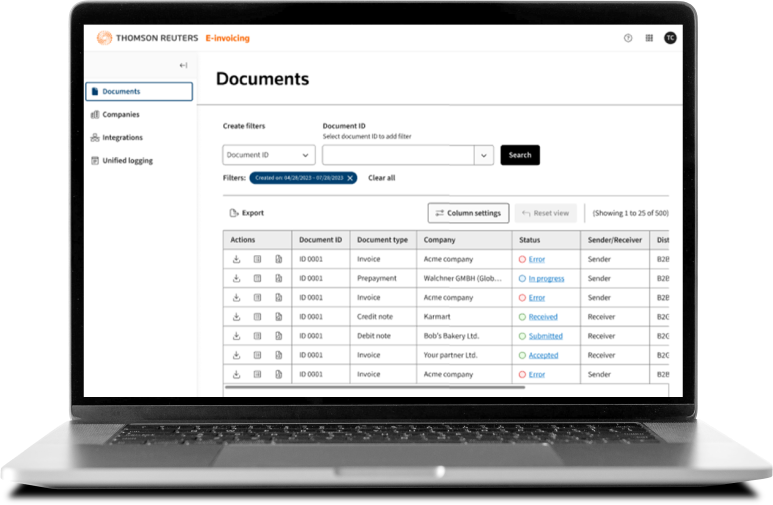In the second installment of our three-part series on e-invoicing, we will explore how e-invoicing and continuous transaction control (CTC) regulations impact tax compliance, and examine some of the challenges and considerations that corporate tax teams may encounter.
The purpose of this series is to help readers gain a better understanding of e-invoicing so that they can stay ahead of the curve when it comes to crafting tax compliance strategies. Nazar Paradivskyy, Vice President of Regulatory Affairs at Pagero, and Jesse Shannon, Senior Product Marketing Manager at Thomson Reuters, shared valuable insights on the essential considerations for companies aiming for a smooth transition into the era of real-time digital tax controls. The first article in the series covered the basics of e-invoicing; the third will address regional differences and the importance of staying current with ever-evolving e-invoicing regulations.
E-invoicing and CTC compliance require a different approach
As we discussed in the first article in our three-part series, e-invoicing mandates are often paired with continuous transaction controls (CTCs), which enable government agencies to implement real-time tax and data reporting. In fact, e-invoicing mandates themselves are often used as a stepping stone to CTC, so even if a government doesn’t require immediate electronic reporting now, it may do so in the near future.
For tax departments, complying with CTC regulations means transitioning away from the traditional, post-audit method of tax reporting, in which auditors collect, compile, and report transaction information in batches, long after the transactions have taken place. Instead, e-invoicing/CTC frameworks allow governments to collect business transaction data as it is happening, through a direct, automated connection with the company’s business software or data-management system. The result is governments having tax-relevant business data many times sooner than the business’s own tax function. Consequently, complying with CTC regulations requires a different approach—one that prioritizes data, accuracy, and speed.
Indeed, to effectively manage e-invoicing/CTC, a company needs appropriate technical systems and data-transfer processes in place, all configured to meet the specific technical requirements of each country. If a company is dealing with multiple tax regimes, the necessary data needs to be simultaneously collected and transmitted to the relevant governments in the format and time frame they require. All this must be implemented in a way that does not disrupt or disproportionately interfere with everyday business processes such as selling (issuing and sending invoices) and buying (receiving and processing invoices). E-invoicing CTC requirements must be embedded within the core business processes and not be an additional separate process.
Part 1: E-invoicing basics for compliance professionals →
Part 3: How to keep up with regional complexities of e-invoicing and CTAs →
Technical and process challenges
To accomplish these objectives, corporate tax departments need to be aware of the technical and process challenges involved, as well as the business implications of their requirements and decisions:
- On the technical side, one of the most pressing challenges facing tax teams is that there are very few international standards for e-invoicing, so every country is free to develop its own invoice formats and technical specifications. Thus, the format and data requirements for e-invoices can vary widely. Some countries only want the basic data used for calculating VAT; others want more: transaction dates, supplier and customer details, itemized product codes, and descriptions, VAT/GST numbers, tax rates, etc. Some countries also require additional data elements for tax compliance, so precision and accuracy are paramount.
- Another complicating factor is that the automated connection between business operating systems and government systems and platforms needs to be seamless, or errors can creep in and cascade. Transaction data needs to be clean and error-free; line items on invoices need to populate the correct data fields, and the data exchange between buyers, the company, the government, and any service providers involved requires systems that are technically compatible.
- Technical issues can also arise from the platforms used for e-invoicing/CTC data exchange. Again, like e-invoice formats, there is no standard platform for communicating e-invoice/CTC data either; the host government chooses—and in some cases develops—the platform. The most popular data exchange platform is Peppol, which is used in several countries and regions, including the European Union, Singapore, and Australia. But there are many other platforms: SDI (Italy), Online Szamla (Hungary), KSeF (Poland), Nemhandel (Denmark), Tieke (Finland), SII (Chile), myInvois portal (Malaysia), to name just a few.
- Finally, there are several different e-invoicing/CTC models for communication between sellers, buyers, governments, and service providers. For example, in the “clearance” model, invoices are approved by a government CTC platform, or certified service provider prior to the completion of the transaction, and once approved, the seller sends the invoice to the buyer. In a “centralized exchange,” however, buyers and sellers are prohibited from directly exchanging documents; rather, the government manages transactions through its CTC platform. In a “decentralized” model, the government outsources invoice validation to a certified network provider. Businesses must consider all these process orchestration differences when setting up their systems and processes.
Whatever combination of challenges a company faces with CTC/e-invoicing, however, it is the company’s responsibility to comply with each country’s technical requirements, invoicing protocols, and CTC regulations—and to stay current with any changes in those rules.
Impact of e-invoicing on tax teams
By now it should be obvious that e-invoicing/CTC mandates are not minor undertakings; rather, they represent a transformational paradigm shift in the way tax teams (and their companies) operate.
To obtain the correct data for e-invoicing/CTC, for example, departments can no longer be siloed—they need to be able to communicate with each other on many different levels. That’s because e-invoicing/CTC not only involves tax teams; it also impacts other departments, including business, finance, support, procurement, and, notably, IT. To manage e-invoicing/CTC effectively, all relevant departments must cooperate and communicate with each other much more fluidly—so much so that many multinational corporations (MNCs) end up creating dedicated teams to oversee the many changes required for a successful transition to all-digital tax reporting.
Turning to technology for e-invoicing/CTC compliance
The bottom line, however, is that no business can manage e-invoicing/CTC compliance without having the proper technology in place. To avoid the headaches that come with trying to create customized e-invoicing solutions on-the fly, MNCs should consider partnering with an experienced solution provider—one that can help the company consolidate its tech stack from CTC, accounts receivable (AR), and accounts payable (AP) automation perspective, facilitate inter-departmental communication, and meet other tax and business requirements associated with e-invoicing, such as statutory reports, trade filings, tax returns, and other compliance requirements. The ideal solution should also include automatic updates to ever-changing e-invoicing/CTC rules around the world because overlooking rule changes can be risky and expensive.
 |
|
Indeed, as digital reporting regimes proliferate around the world, MNCs that operate in different global regions face a multitude of challenges due to country-to-country differences in e-invoicing specifications and protocols, not the least of which is that the requirements themselves are constantly changing.
The ideal solution should not only meet the specific requirements of the tax function, but should also encompass accounts receivable (AR) and accounts payable (AP) automation capabilities from a broader business standpoint. In addition to facilitating real-time data sharing with governments, the exchange of invoices, status messages, orders, and dispatch advice should be prioritized with your trading partners.
Going for a pure compliance solution would create unnecessary overhead from a cost, process, and technology perspective. Businesses should seriously consider leveraging an open, interoperable Network that embeds CTC compliance with AR and AP business automation processes in one go to gain the full value of the e-invoicing CTC mandates introduced by governments all over the world.
In the next installment of our three-part series, we will take a more in-depth look at how e-invoicing mandates are being implemented in different parts of the world, and what companies need to do to stay ahead of the curve.
Discover how global organizations can save money and speed compliance for e-invoicing and real-time reporting in the e-invoicing compliance white paper.







